paulvallandigham said:Now I understand why the percussion lock has never been fired!( Note rust in pictures) There is NO way those lock bolts are going to withstand the backpressure against that drum. :nono: I believe you will be breaking the wood around the lock mortise, and endangering your forehand if you fire the gun that way.
Please don't risk injuring yourself or others with this percussion design. Shoot the gun as a flinter, instead. :shocked2: :thumbsup:
I have documentation of the percussion lock being used, and the load data. I am surprised that a master gunsmith and a gun builder with over 40 years building guns would create a harmful gun!
What gives?














